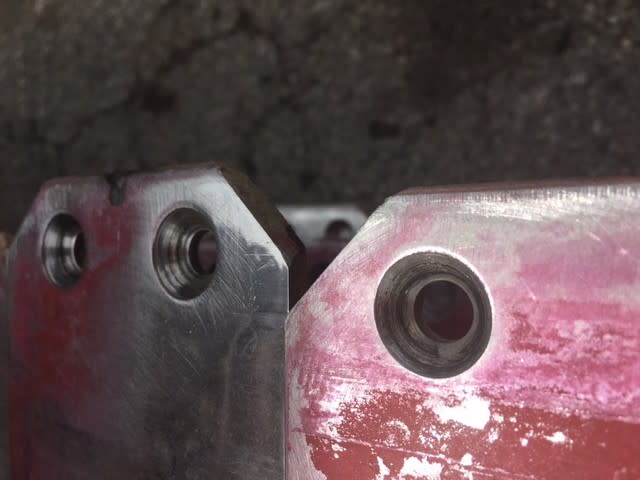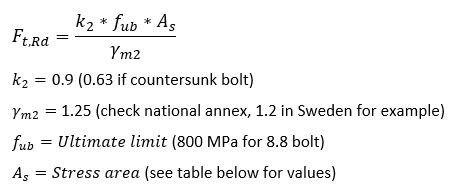Navigation
Install the app
How to install the app on iOS
Follow along with the video below to see how to install our site as a web app on your home screen.
Note: This feature may not be available in some browsers.
More options
Style variation
-
Congratulations MintJulep on being selected by the Eng-Tips community for having the most helpful posts in the forums last week. Way to Go!
You are using an out of date browser. It may not display this or other websites correctly.
You should upgrade or use an alternative browser.
You should upgrade or use an alternative browser.
What Type of Hole Provides Better Retention of a Part - Counterbored or Countersunk 9
- Thread starter Finglas
- Start date
- Status
- Not open for further replies.
-
2
- #2
JohnRBaker
Mechanical
Counterbored versus countersunk, you're dealing with two different situations and it depends on how the screws are ultimately fastened. In both cases, the result is that heads of the fasteners do not protrude above the surface of the item being mounted, particularly if the countersunk holes also have a slight counterbore. Using counterbored fasteners works well if the screws are going into tapped holes, as the tolerance for the location of the holes are not as critical as it would be if you were using countersunk screws. What that means is that it's often better that countersunk screws are retained using a nut, that way it's the tolerance of the mating through hole that's more relevant.
And then there's the resulting 'environment'. I spent 14 years designing machinery for commercial bakeries where sanitation was an important design criteria. That meant that counterbored fasteners were generally avoided as the counterbored holes, even when the fastener was there, was seen as a cavity which could harbor 'vermin' and which could make it very difficult to keep clean.
But getting back to your original issue, if properly sized, I suspect that either approach would work for you.
Anyway, just a few thoughts.
John R. Baker, P.E. (ret)
Irvine, CA
Siemens PLM:
The secret of life is not finding someone to live with
It's finding someone you can't live without
And then there's the resulting 'environment'. I spent 14 years designing machinery for commercial bakeries where sanitation was an important design criteria. That meant that counterbored fasteners were generally avoided as the counterbored holes, even when the fastener was there, was seen as a cavity which could harbor 'vermin' and which could make it very difficult to keep clean.
But getting back to your original issue, if properly sized, I suspect that either approach would work for you.
Anyway, just a few thoughts.
John R. Baker, P.E. (ret)
Irvine, CA
Siemens PLM:
The secret of life is not finding someone to live with
It's finding someone you can't live without
-
1
- #3
TugboatEng
Marine/Ocean
Counterbored screws do not provide additional location compared to a standard bolt.
Countersunk screws provide very positive location to the point that tolerancing hole position can be difficult if many screws are used.
If positive location is required, a pair of dowel pins is usually sufficient.
For the highest rigidity, body fitted bolts are best.
Countersunk screws provide very positive location to the point that tolerancing hole position can be difficult if many screws are used.
If positive location is required, a pair of dowel pins is usually sufficient.
For the highest rigidity, body fitted bolts are best.
counterbored hole provides more rigidity as the screwhead has a flat surface to screw up against.
I would tend to argue that countersunk provides both rigidity as well as lateral motion resistance, since the slope translates retention force into 3D space.
TTFN (ta ta for now)
I can do absolutely anything. I'm an expert! faq731-376 forum1529 Entire Forum list
Depends on what type of screw? C'sink would be for a flat head screw. C'bore could be for a screw, or bolt, normally where the head sits below the surface.
For better retention, I would pick a type other than a flat head, the head can shear off during torque or vibration.
Chris, CSWP
SolidWorks
ctophers home
For better retention, I would pick a type other than a flat head, the head can shear off during torque or vibration.
Chris, CSWP
SolidWorks
ctophers home
What galactic forces are conspiring to move or re-move the "retained" part ?
The real Gen II Chrysler hemi V8 engines had their flywheels and crankshafts attached with 8 1/2" bolts torqued to 90 or so lb-ft.
I think that is a moderately demanding retaining job.
The real Gen II Chrysler hemi V8 engines had their flywheels and crankshafts attached with 8 1/2" bolts torqued to 90 or so lb-ft.
I think that is a moderately demanding retaining job.
- Thread starter
- #8
There are several advantages to using a counterbore hole, including more holding strength. A counterbore usually has more holding strength compared to a countersink hole because the force applied by the socket cap screw head is parallel to the axis. The force applied by the screw or bolt is distributed evenly over a larger surface area. This is not the case with a countersunk hole, which has tapered sides. As a result, the force applied by the screw or bolt is not evenly distributed, but dispersed at an angle or along the slope of the hole.
-
2
- #9
Variation on toleranced head angle and countersink angle indicate that there is limited contact between countersink and head. Not to mention surface texture of countersink seat which will burnish under load and vibration resulting in loss of tension.




-
1
- #10
geesaman.d
Mechanical
^ Agreed.
Countersunk screws are rarely used alone or over deep holes, which makes them both difficult to hold tolerances but also ensures that the contact of the tapered seat is never perfect. And if we take a moment to think about that instant when the screw first touches the taper (which is almost always on one side of the taper), then it's clear that further tightening applies bending moment to the head of the screw. That means a good amount of the tensile strength and torque is wasted on forces other than tension.
Counterbored screws aren't without their challenges but they do put the vast majority of their strength into grip force.
Countersunk screws are rarely used alone or over deep holes, which makes them both difficult to hold tolerances but also ensures that the contact of the tapered seat is never perfect. And if we take a moment to think about that instant when the screw first touches the taper (which is almost always on one side of the taper), then it's clear that further tightening applies bending moment to the head of the screw. That means a good amount of the tensile strength and torque is wasted on forces other than tension.
Counterbored screws aren't without their challenges but they do put the vast majority of their strength into grip force.
-
3
- #11
Hi,
In term of bolt strength according to EN 1993-1-8, table 3.4, the tension resistance of countersunk bolt is about 70% compared to the other head types (by comparing factor k2, 0.63 / 0.9 = 0.7)

Engineering is a journey of thousand miles begins with a single step
In term of bolt strength according to EN 1993-1-8, table 3.4, the tension resistance of countersunk bolt is about 70% compared to the other head types (by comparing factor k2, 0.63 / 0.9 = 0.7)

Engineering is a journey of thousand miles begins with a single step
I suggest that counter-sinking starts the bolt braking more,
as it must banana some in real-world.
However sending a 10mm bolt bent is a little difficult in a doing-up scenario
I suggest that ultimate retention is created with a shoulder bolt of large headed proportion,
I bet socket heads have better retention than countersunk (the counter-sunk was the drawn one,
possibly through the head side object also, not the head drawing purely)
and that hex heads are better again
getting material behind a shaft/shank is difficult it seems, as it falls to the
shank/shaft of the bolt which will part
-beyond drawing a head. Seems the shank breaks, as many of us have done exactly that,
turned a left hand screw too far wrongly
A countersink is a pinning arrangement though, if you wish to locate.
Beyond breakage and drawing, the countersink will locate, where a counter-bore must be able to flog
-although only a little
as it must banana some in real-world.
However sending a 10mm bolt bent is a little difficult in a doing-up scenario
I suggest that ultimate retention is created with a shoulder bolt of large headed proportion,
I bet socket heads have better retention than countersunk (the counter-sunk was the drawn one,
possibly through the head side object also, not the head drawing purely)
and that hex heads are better again
getting material behind a shaft/shank is difficult it seems, as it falls to the
shank/shaft of the bolt which will part
-beyond drawing a head. Seems the shank breaks, as many of us have done exactly that,
turned a left hand screw too far wrongly
A countersink is a pinning arrangement though, if you wish to locate.
Beyond breakage and drawing, the countersink will locate, where a counter-bore must be able to flog
-although only a little
- Status
- Not open for further replies.
Similar threads
- Locked
- Question
- Replies
- 3
- Views
- 2K
- Locked
- Question
- Replies
- 7
- Views
- 3K
- Locked
- Question
- Replies
- 3
- Views
- 685
- Replies
- 12
- Views
- 4K
- Replies
- 7
- Views
- 8K

